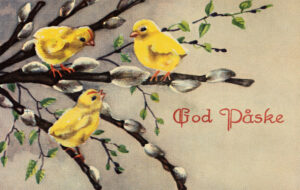
Easter in Scandinavia – We have posted about Norway’s Påskekrim and the Easter Trees in Sweden but here are a few traditions from all the Nordic countries.
Denmark — Påskeferie
Påskefrokost
Påskefrokost is Easter lunch, and it’s commonly the first event of the season at Danish summerhouses. Virtually a day long meal it stretches from lunch to dinner.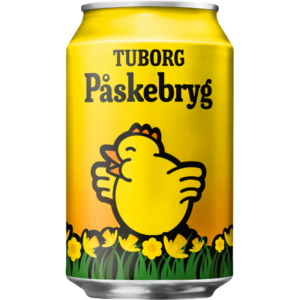
And there is also plentiful amounts of alcohol. For Påske, this includes akvavit and Påskebryg, a special beer that’s launched in early March and only available until Easter.
Gækkebrev
In English, this means “teasing letters.” The letters contain short poems are sent and signed using one dot for each letter in the sender’s name. The recipient has to guess the name of the sender, if they guess correctly, they get a chocolate Easter egg. And if they get it wrong, they have to give a chocolate egg to the sender.
Eggs & Candy
Eggs are also a big part of Easter in Denmark. They are often served at Påskefrokost (Easter breakfast)and egg tosses are a popular activity. Royal Copenhagen produces a new porcelain Easter egg each year, which can be opened and filled with candy.
And like Sweden, in Denmark there are Easter Witches. Children dress up as witches and warlocks and go door-to-door asking for candy. But, the kids give the people something in return. They give each house a decorated willow branch, as thanks for the chocolate gifts they’ve received. These willow branches are believed to bless the owner’s house.
 Finland — Pääsiäinen
Finland — Pääsiäinen
Pääsiäinen is a big deal in Finland perhaps because it’s a major religious holiday for Finland’s 4.2 million Lutherans (nearly 80% of the population). It marks the first holiday of spring.
The week of Easter, shops fill with the expected bunny/chick/chocolate kitsch, and at the same time flower shops and market stalls begin selling a lovely arrangement of palm leaves, pussy willows, and daffodils.
Festivities begin on Palm Sunday with a parade through town and the requisite church-goers walking around with palm leaves. Palm Sunday also brings Virpominen, the Finnish equivalent of America’s Halloween. The children dress as witches and goblins going door to door asking for candy. But instead of saying “Trick or Treat,” they offer a blessing and often wave or give out pussy willow branches, a sign of the coming spring and of rebirth. There is often an Easter bonfire on one of the many islands around Helsinki and the children will dress up for that too.
Easter in Finland is full of Easter-related projects at school where the Finnish children plant Rye grass and watch it grow in the days leading up to Easter. Then the Easter bunny nestles eggs and treats into the grass instead of into plastic grass. So, they spend Easter watching grass grow. Draw your own conclusions.
Iceland — Öskudagur
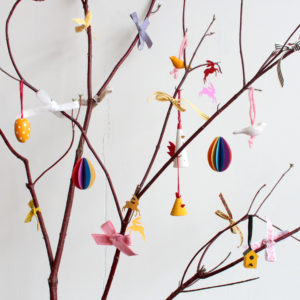
Ash Wednesday is primarily celebrated by children in Iceland. Ashes were collected and placed into small ash bags then you would try to pin the bag on an innocent passerby. Today children celebrate by dressing up in costumes and singing in shops for sweets and treats, a little like Halloween celebrations.
Easter in Iceland is marked by the giving and receiving of large chocolate eggs filled with sweets. It is a five-day weekend, from Maundy Thursday to Easter Monday, with all schools and offices shut, as well as some shops too. Many people use this long weekend to travel – often visiting family or friends. There is also a famous ski festival and music festival, both of take place at the same time in the town of Ísafjörður.
In fact, people from Ísafjörður buck the trend of traveling and choosing instead to stay home and enjoy the party as their town literally doubles in size for the weekend.
Icelandic Easter eggs are a little bit special. Each one comes decorated with chicks and flowers, is filled with a rainbow of different sweets, and has a little slip of paper in it with a fortune.
Norway — Påske
Påske in Norway is a time of year that marks the end of the long Winter. Symbols of Easter Chickens and eggs are the usual symbols of a Norwegian Easter. The egg symbolizes rebirth and the chicken has been a symbol of fertility since ancient times. Yellow is the most traditional color of Norwegian Easter. Lush green is also popular as it symbolizes life and growth.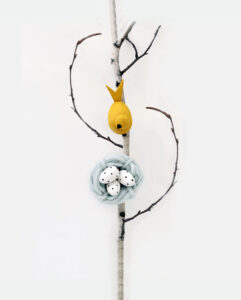
Palm Sunday marks the start of the Easter holidays and is when people to start to decorate their homes for Easter. Homes hang their summer curtains, put out seasonal table cloths, oven mitts, and wall hangings. Easter crafts are a usual activity – painting and decorating eggs, making paper baskets and cards, and sewing or knitting Easter ornaments. Yellow candles are very popular and so are yellow flowers such as daffodils and tulips.
Many people go on holiday to påskefjellet, ‘the Easter mountain’ – their mountain cabins, camping or skiing. Those who have an Easter at home have a bypåske, city Easter.
Påskekrim (or Easter crime) is a tradition at Easter in Norway. You can read about it in a previous post here.
Sami — Beassáš-Márkanat
During the Easter long weekend the Sami in Kautokeino, Northern Norway, hold their annual Sami Easter Festival. The festival is a showcase of Sami life and includes the Sami Music Festival, the World Reindeer Racing championships and the Sami Film Festival.
Sweden – Påsk
Many Swedes celebrate Easter in the country together with relatives from near and far. It’s a great opportunity to open up the holiday house, cleaning away winter dust and scaring off the mice. In some parts of the country bonfires are an important part of the Easter tradition.
Easter Trees are part of Swedish tradition. You can read about that here.
In Sweden and parts of Finland, what looks like our Halloween takes place on either the Thursday or Saturday before Easter. Children dress up as witches and go door to door with a copper kettle looking for treats.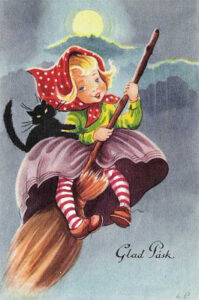
The tradition is said to come from the old belief that witches would fly to a German mountain the Thursday before Easter to cavort with devil. On their way back, Swedes would light fires to scare them away. This practice is honored today by the bonfires and fireworks in the days leading up to Sunday.
Påskbrasa (Easter Bonfire)
To scare witches away, the people used to light up large bonfires called påskbrasor. This custom is still common in the southwest part of Sweden, in particular in the province of Bohuslän. Recently the custom has become quite large creating problems on the islands outside of Gothenburg, where people have discovered that old Christmas trees make excellent bonfires. People are competing for the biggest fire and are even raiding neighboring villages and suburbs to steal their old Christmas trees. The bonfires have grown to a size that the fire brigade is needed to keep them under control. Local governments have to issue decrees of when, where, and how fires are allowed.
Whatever your traditions are, we wish you a Happy Easter.